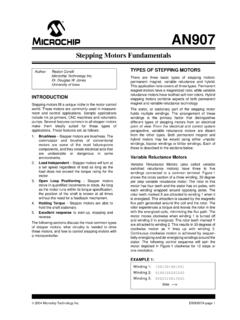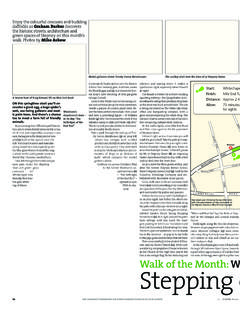Transcription of STEPPING UP THE PACE: IMPROVING ATTENDANCE
1 1 STEPPING UP THE PACE: IMPROVING ATTENDANCE STEPPING UP THE PACE: IMPROVING ATTENDANCE A How to Mini-Guide M. H. West & Co., Inc. TA Provider for Philadelphia MEES* Funded thru the ETA-DYS March 31, 2012 2 STEPPING UP THE PACE: IMPROVING ATTENDANCE IMPROVING ATTENDANCE : Challenge for Urban Schools IMPROVING student ATTENDANCE is a huge challenge confronted by urban high schools. The importance of ATTENDANCE is clear; students need to be present in school to benefit from the curriculum, meet academic and other diploma requirements, and partake in special opportunities that school offers. Yet, urban high schools experience substantial ATTENDANCE difficulties evidenced by high absentee rates, student tardiness, class skipping, and suspensions/expulsions.
2 Promising practices, aimed at IMPROVING ATTENDANCE , exist in high schools across the nation both as a part of larger school turnaround initiatives and as school/ ATTENDANCE improvement efforts. What we know is that there are no silver bullet approaches -- there is no magic formula nor is there a canned approach capable of reaching and sustaining high levels of student ATTENDANCE . Successful schools work on ATTENDANCE issues on multiple fronts, over time, learning from the field, and learning from the results of their own efforts. These schools know that boosting ATTENDANCE is a continuous process. As students, families, communities, and schools change, so must strategies aimed at IMPROVING ATTENDANCE . Successful schools face the big question head on -- How are we contributing to absenteeism and how can we work with parents and communities to keep young people engaged, in school, and learning what they need to know to be successful?
3 There is no question that ATTENDANCE improvement is part of fostering a school culture conducive to learning. Student ATTENDANCE is, in fact, one of several ways through which progress on this front is measured. Increases in ATTENDANCE provide one indicator that efforts in school transformation/turnaround are taking hold as a school works to achieve: High expectations, strong student supports Climate of respect and caring Learning that is rigorous, challenging, relevant, and engaging Safe and orderly learning environment Student belonging, connectedness, and feelings of affiliation Personalized learning environment Interventions appropriate to meet students academic needs We also know, from the research, that poor school ATTENDANCE is also a predictor part of an early warning system signaling that a student or groups of students are at risk of dropping out of school.
4 Students with chronically unexcused absences are at risk for serious behavioral issues such as substance abuse, criminal activity, and incarceration. Dealing with school ATTENDANCE is very important. 3 STEPPING UP THE PACE: IMPROVING ATTENDANCE Why are students absent from school? A book could be written about this alone. The research looks at four types of factors -- student factors (poor health, substance abuse, academic difficulties, fear of bullying, and peer pressure), school factors (negative climate, inflexibility, safety issues, and inability to deal with truants), family factors (lack of supervision/guidance, different priorities, dissatisfaction with school, and lack of familiarity with school laws), economic factors (student employment, poverty, and lack of family child care).
5 What do students say? Among the reasons students give for not legitimate absence are: Classes are boring and not relevant They do not have positive relationships with teachers They do not feel safe at school and in transit No one seems to care They have academic difficulty, are not successful, and there is little help Peer influences are negative and strong The school environment is uncomfortable WHAT CAN SCHOOLS DO? Successful Schools: Stay focused on IMPROVING student engagement through curriculum, instruction, academic and student support interventions, career development, climate, and safety initiatives Work hard IMPROVING student ATTENDANCE , in a systematic way, throughout the year and over the years Address the different forms of ATTENDANCE problems the school is evidencing: o Absences o Tardiness o Class skipping o Suspension/Expulsion Use a tiered intervention structure -- a continuum of strategies and practices: o Prevention for all students, establishing expectations and positive school climate.
6 Fair policies and procedures, 4 STEPPING UP THE PACE: IMPROVING ATTENDANCE o Early Intervention for students on the verge of evidencing significant ATTENDANCE problems -- Address barriers to ATTENDANCE with targeted interventions specific to students o Intensive Intervention for students evidencing patterns of chronic ATTENDANCE problems Select strategies that are specific to needs and within the school s capacity to implement well Engage students, families, and community in solution-building 5 STEPPING UP THE PACE: IMPROVING ATTENDANCE STEPPING UP THE PACE: IMPROVING ATTENDANCE This mini-guide, provides a quick and easy format providing information, strategies, and tips to help schools work on ATTENDANCE issues. It is a companion to ATTENDANCE Academy type professional development giving staff tools to clarify problems and build just right solutions.
7 This how to mini-guide culls from a variety of sources and presents information in a concise format so that school staffs have a ready resource. This Guide focuses on prevention and intervention, not the legal side of truancy. IMPROVING ATTENDANCE : A Comprehensive Approach CHECKLIST: KEY ELEMENTS OF A COMPREHENSIVE APPROACH Drawn from: Components of a Comprehensive School-Based Approach to Increase ATTENDANCE , 2010 Create a strong ATTENDANCE data collection and dissemination system that helps target interventions early and often, including an early warning system Reduce school initiated exclusions, such as suspension Partner with families early on and often Create a communication/media campaign regarding the importance of ATTENDANCE Create a uniform system, but one that has the flexibility to address individual needs Focus on prevention, intervention, and recovery rather than punishment and legal intervention Develop an individualized, comprehensive plan of services and supports, with case management, for students in need of intensive intervention Focus on high need populations, grades.
8 And times of year when ATTENDANCE problems are most prevalent Use rewards and incentives effectively Provide training to all school staff Focus on proven universal strategies building positive culture, welcoming environment, engaging instruction Address transportation and safety barriers, such as safe passage strategies Listen to the youth voice and learn from students about how to improve ATTENDANCE Engage the community in supporting school ATTENDANCE Use referrals to law enforcement as last resort 6 STEPPING UP THE PACE: IMPROVING ATTENDANCE IMPROVING ATTENDANCE : Some Practical Tips This How to Mini-Guide focuses on strategies and tips. Some practical tips for schools in tackling the broad range of ATTENDANCE issues, includes: BASIC TIPS: Know your ATTENDANCE laws, local policies, and their inconsistencies Focus on student engagement, not just truancy Adopt promising practices that fit locally and are doable within your school Select approaches that are in line with school strengths/assets Create both incentives and graduated sanctions, the carrots and the sticks Turn mistakes into learning opportunities rather than failures meriting punishment Reinforce explicit expectations for positive behavior and academic success Reward and recognize good ATTENDANCE , not just perfect/great ATTENDANCE .
9 The idea is to improve the incidence of both excused and non-excused absences. Schools do want students to stay home and get better when they are ill and when they can spread illness to others Take baselines and track progress, use data to signal need for mid-course corrections Do not provide temptation. Close campuses during breaks and lunch TIPS IN WORKING WITH STUDENTS: Greet students by name, so that no student is invisible Strive to have every student feel close to a supportive adult at the school Let students know that when they are not in school, they are missed Create an environment where every student can be successful in something Help students to see the facts -- a high school diploma is important to their future; ATTENDANCE is important to achieving the credential Involve students in planning programs to improve ATTENDANCE and engagement Seek the student voice in school improvement 7 STEPPING UP THE PACE: IMPROVING ATTENDANCE TIPS IN WORKING WITH PARENTS.
10 Foster a welcoming environment for parents in the school Provide clear message to parents that school ATTENDANCE is important Have an ATTENDANCE point of contact for every parent with the school Share ATTENDANCE improvement ideas with parents and seek their suggestions When a student is absent, immediately talk to their family member in person, not an answering machine Provide parent-to-parent tips on what they can do to help their children make it to school, on time, and ready Involve parents in case management and school-family counseling for chronic absentee situations TIPS FOR WORKING WITH THE COMMUNITY: Seek referrals to other agencies to help students with problems outside of the school s purview Identify community organizations who can help and the specific ways that they can support the school s ATTENDANCE improvement efforts Engage the local business community in providing discounts to students who earn positive ATTENDANCE cards, as well as other ATTENDANCE incentives Forge a relationship with local businesses and services -- where youth may congregate encourage them to help you keep students in school during school hours Consider creating and disseminating a poster with your branded message, plus the following type of statement: We support youth in school and will not serve students during school hours Bring together a community leaders focus group.






